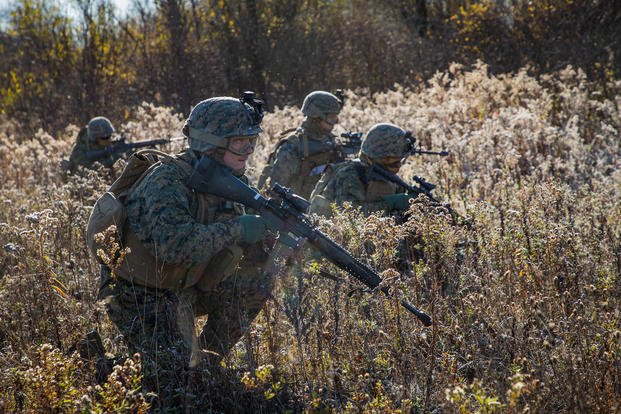The Marine Corps has put a lot of emphasis on countering China, but tens of thousands of East Coast leathernecks have their sights set on another part of the world.
Members of II Marine Expeditionary Force wrapped up a training exercise last week that ran from North Carolina to New York. The Marines were tasked with taking back territory in a friendly country that was invaded by a near-peer adversary.
It's a scenario not unlike Russia's effective annexation of Ukraine's Crimean Peninsula in 2014.
The exercise, called Marine Expeditionary Force Exercise -- or MEFEX -- 21.1, matches the focus that Commandant Gen. David Berger put on II MEF readying for missions in the Atlantic and Europe.
Read Next: New DoD Adviser Has Made Controversial Proposal: Get Rid of the Marine Corps
Lt. Gen. Brian Beaudreault, II MEF's commanding general, told reporters Friday that if U.S. troops are called up to respond to a crisis in Europe, his Marines are going.
"We're not just saying we can go do it," he said. "We're demonstrating we're ready to go do it."
The exercise ran for nearly six weeks, stretching from Camp Lejeune in North Carolina to Fort A.P. Hill in Virginia up to Fort Drum in New York. Troops from several other countries participated in the exercise, including Norway, the United Kingdom and Canada.
The Navy's 2nd Fleet also participated, and Beaudreault called the naval integration portion of the exercise one of the most important pieces.
"It's [about] the Marine Corps unlocking the ability of the Navy to maintain naval maneuver," he said. "That's important in Pacific theater, given a likely threat, and it's definitely important in the European theater, given the threat that can emanate out of [Russia's] Northern Fleet."
Berger's planning guidance has come under scrutiny by some for putting so much emphasis on China. But Beaudreault said that, while the planning guidance has a Pacific focus, it's not a "Pacific-only" strategy.
After decades of land warfare and crisis-response missions, the Marine Corps is moving back toward its naval roots. If war breaks out in Europe, Beaudreault said, there's "very much a maritime component to that."
The Marines can set up expeditionary advanced bases, assist in anti-submarine warfare by establishing refueling sites for maritime patrol aircraft, boost ships' unmanned sensing capabilities, and carry out long-range precision fires from ashore, he said.
The high-end fight Marines were simulating required personnel to think differently about threats. Electronic signatures are a big concern in that type of environment, and Beaudreault said cell phones weren't allowed inside operating spaces. If it comes to a real-world battle against a sophisticated adversary, the general said he'd issue a MEF-wide order banning Marines from using them in theater.
"We don't have to keep relearning the lessons we've learned," he said. "I think everybody's aware of the classic one [in which] somebody at a forward operating base was running web around their compound, over and over.
"It's a real concern ... if you're trying to stay hidden, so we take it seriously."
One thing that was absent in the exercise were tanks, as the Marine Corps gets rid of some of its heavy equipment to travel light and save money for newer technology.
Beaudreault said the MEFEX proved that allies can fill the gaps and Marine aviators can "kill armor at ranges that exceed a tank gunner."
The exercise culminated with one of the longest tactical convoys in recent Marine Corps history.
Members of Combat Logistics Regiment 27, led by a first lieutenant, completed a 916-mile tactical convoy from New York to North Carolina in two-and-a-half days. Beaudreault called it a tremendous accomplishment.
"It's not unrealistic to think that, based on where the enemy is and based on where we are, and the distances that we're going to have to cover to push an enemy out, that we may have to go those distances," he said. "... And in combat is not the first time we want to do that."
-- Gina Harkins can be reached at gina.harkins@military.com. Follow her on Twitter @ginaaharkins.
Related: Marine 3-Star Hits Back at Claims that Corps' Future Design Is Too China-Focused












